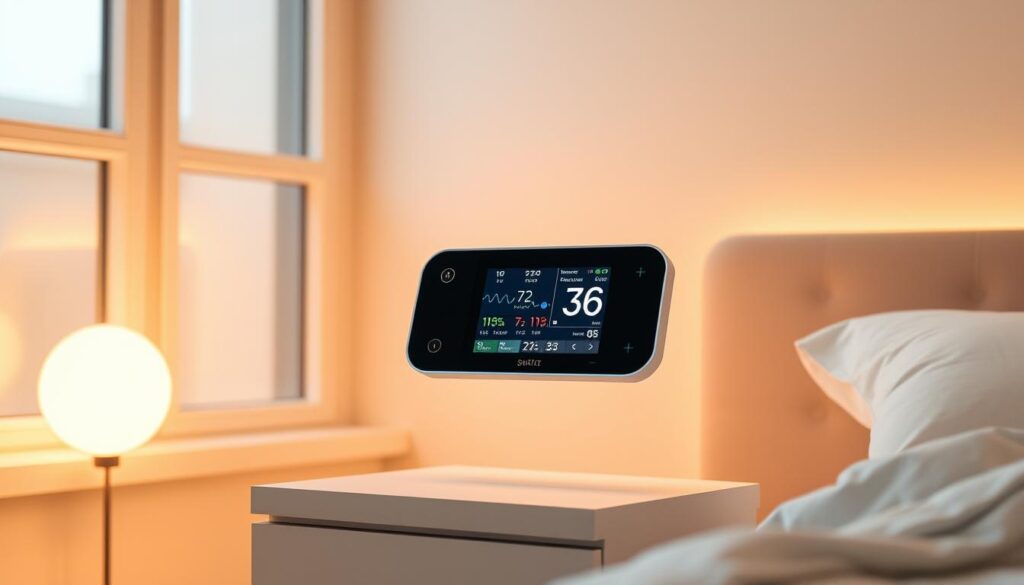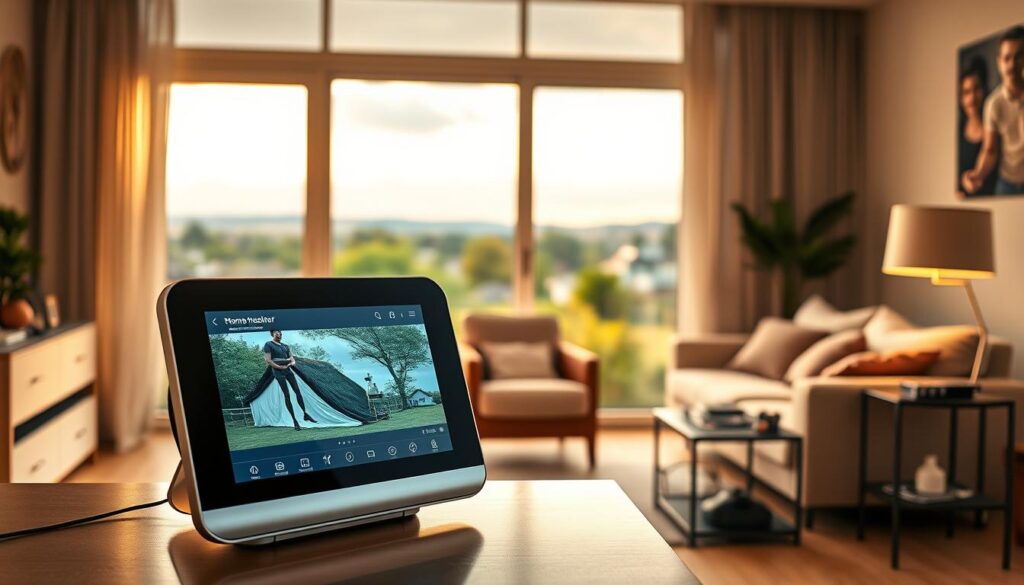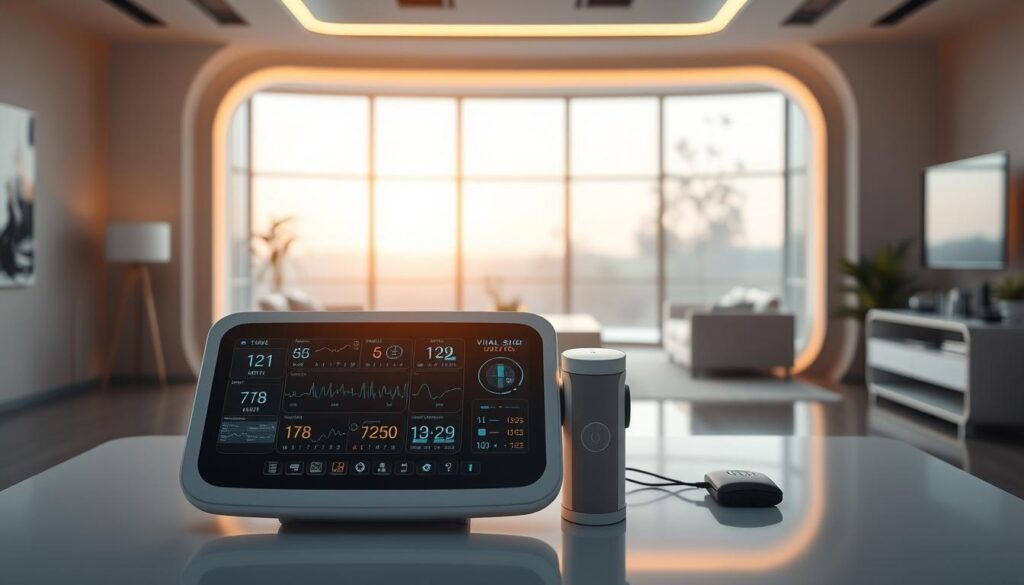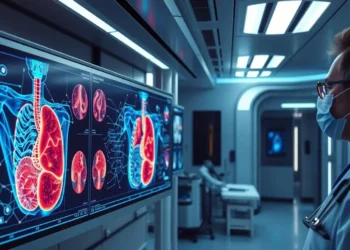Did you know nearly 50 million Americans now control their health better with remote monitoring devices? This shows how big a change is happening in home healthcare. Technology is key in making patient care better and easier.
More than 80% of Americans want to monitor their health from home. This is changing healthcare fast to meet their needs.
Thanks to new tech like Bluetooth blood pressure monitors and glucose trackers, doctors can get data right away. This helps them act fast on chronic conditions. It also cuts down on hospital visits, making care better for patients.

Table of Contents
The Rise of Home Healthcare Remote Monitoring
Home healthcare remote monitoring has changed how we care for patients. It started with simple checks like blood pressure and heart rate. Now, it includes advanced systems for managing chronic conditions like diabetes and heart disease from home.
This technology lets patients work closely with healthcare providers. It has led to better health outcomes for many.
Transformative Impact on Patient Care
Home healthcare remote monitors use smart devices to collect data. These devices track important health signs and adjust care as needed. IoT tools like connected scales and smart pill dispensers also play a big role.
They help patients take charge of their health while doctors keep an eye on them. Studies show this approach can cut down on hospital visits, saving money and improving care.
The Shift in Healthcare Delivery
Telehealth services have made healthcare more focused on the patient. Remote monitoring is especially helpful in areas where healthcare is hard to reach. AI helps spot health problems early, leading to quicker help.
This way, healthcare teams can help more people with less. As more people live longer and face chronic conditions, the need for these services will only grow.

Understanding Remote Health Monitoring Systems
In today’s fast-changing healthcare world, remote patient monitoring is key. It lets doctors check on patients from afar, making care better and safer. This tech is crucial for managing long-term illnesses and boosting health results.
What is Remote Patient Monitoring?
Remote patient monitoring (RPM) uses devices to collect health data from patients. It tracks important health signs like blood pressure and heart rate. Thanks to telemedicine tools, doctors can see this data in real-time, acting fast if needed.
Research shows RPM cuts down on hospital stays and deaths, especially for high-risk patients.
Key Components of Remote Healthcare Technology
Effective remote healthcare tech has several parts. Key devices include:
- Smart wearables that monitor daily activities and vital signs
- Continuous glucose monitors for real-time blood sugar tracking
- Blood pressure monitors that help maintain cardiovascular health
- Telehealth platforms that connect patients with providers for virtual consultations
These tools work together, giving a full picture of a patient’s health. They let doctors tailor care to each patient’s needs, improving chronic condition management. Hospitals find it helps reduce overcrowding and ensures timely care, boosting healthcare quality.
| Device Type | Functionality | Impact on Patient Care |
|---|---|---|
| Smart Wearables | Track physical activity and vital signs | Enhances patient engagement and encourages healthier lifestyles |
| Continuous Glucose Monitors | Provide real-time glucose level data | Facilitates proactive management of diabetes |
| Blood Pressure Monitors | Measure and record blood pressure | Helps prevent hypertensive crises through regular tracking |
| Telehealth Platforms | Enable virtual consultations | Improves accessibility and convenience for patients |

The Importance of Home Healthcare Remote Monitor
Using a home healthcare remote monitor has changed how patients manage their health, especially for those with chronic conditions. These devices let you see important health data in real-time. This helps you stay up-to-date with your health status.
This constant monitoring lets you make quick decisions. It also helps you manage your health more actively.
Empowering Patients with Real-Time Data
Real-time data from a home healthcare remote monitor lets you take charge of your health. Studies show that when patients monitor their health, they feel more responsible. This can lead to better communication with doctors and better health results.
By tracking vital signs every day, remote patient monitoring spots changes early. This means you can get help quickly if something is wrong.
Enhancing Care for Chronic Conditions
For people with chronic conditions like diabetes or high blood pressure, remote monitoring makes care better. It gives doctors a clear picture of your health, helping them create care plans just for you. Research shows that RPM can lower hospital visits by catching problems early.
By adding remote monitoring to home care, companies can use resources better. This makes patients happier with their care.
Types of In-Home Monitoring Devices
In-home monitoring devices are key in modern healthcare. They let patients manage their health at home. These devices, like smart wearables and continuous glucose monitors, track vital signs. They give important info for better health.
This section talks about different in-home monitoring devices. They improve patient care and help manage chronic conditions.
Smart Wearables: Your Health Companion
Smart wearables, like fitness trackers and smartwatches, are your health buddies. They watch your heart rate, sleep, and activity. They give real-time data to keep you updated on your health.
Many smart wearables also send data to healthcare systems. This lets doctors keep a closer eye on you.
Continuous Glucose Monitors for Diabetes Management
For those with diabetes, continuous glucose monitors (CGMs) are vital. They track blood sugar levels in real-time. This lets patients see how their diet and activities affect their health.
With cellular-enabled glucose meters, users can share their data with doctors. This helps create personalized health plans. It improves diabetes care.
Blood Pressure Monitors: Keeping Hypertension in Check
Blood pressure monitors are key for those with high blood pressure or heart conditions. The newest models send readings wirelessly to doctors. This makes it easier for them to act fast.
Regular home checks help patients stay on top of their health. It also cuts down on hospital visits.
| Device Type | Purpose | Key Features |
|---|---|---|
| Smart Wearables | Track physical activity and vital signs | Heart rate monitoring, sleep tracking, data synchronization |
| Continuous Glucose Monitors | Manage diabetes | Real-time blood sugar tracking, data sharing capabilities |
| Blood Pressure Monitors | Monitor blood pressure levels | Bluetooth connectivity, automatic readings |
Telehealth Services: Bridging the Gap
Telehealth services are changing how we get healthcare, especially for those with chronic illnesses. They use telemedicine tools to keep patients and doctors in touch. This helps patients stay involved and get better care, leading to better health results.
The Role of Telemedicine Monitoring Tools
Telemedicine tools are key for managing health from afar. They let patients send health data to doctors. For example, people with Type 2 diabetes saw their HbA1c levels drop by -2.19% with telemedicine help.
Collaborative Care with Virtual Nursing
Virtual nursing adds support from experts in real-time. It helps cut down on clinic visits but keeps care comprehensive. A mix of in-clinic and remote care has shown great results, especially for diabetes.
| Service Type | Impact on Patient Care | Statistics |
|---|---|---|
| Telehealth Services | Improves access to healthcare, especially in rural areas. | 44% reduction in emergency visits; 20% increase in adherence. |
| Telemedicine Monitoring Tools | Enhances real-time data collection and patient engagement. | -2.19% reduction in HbA1c for Type 2 diabetes patients. |
| Virtual Nursing Care | Facilitates additional support and guidance for chronic illness management. | 80% of providers see quality improvement with telemedicine. |
Telehealth services make healthcare easier and more accessible. Using telemedicine tools and virtual nursing can help manage health better. This means fewer hospital visits and happier patients.
Benefits of Remote Patient Monitoring
Remote patient monitoring (RPM) makes healthcare more accessible and affordable. It helps patients in rural areas or with mobility issues get quality care at home. This way, patients can manage their health better, needing fewer in-person visits.
Increased Accessibility for Patients
RPM brings healthcare closer to patients. It removes the need to travel to a healthcare facility. Studies show a big jump in access, from 65% to 90%, after RPM was introduced.
This technology helps patients stay in touch with their healthcare providers. It encourages them to manage their health proactively.
Cost-Effectiveness in Healthcare
RPM is also a cost-effective solution in healthcare. It cuts down direct healthcare costs, from $25,000 to $12,000 on average. This is due to fewer hospital readmissions and less travel.
Patients also face less disruption in their lives. Healthcare visits drop from 2.5 to 1.5 on average. Plus, RPM lets healthcare providers grow their services without needing more staff or resources.
Challenges in Implementing Remote Healthcare Solutions
Remote healthcare solutions face unique challenges. Data privacy is a big concern. Sensitive health info is sent over networks, needing strong security to keep it safe.
Technology adoption is hard, especially for the elderly. They may find digital health tools hard to use. Also, making these systems work with current electronic health records (EHR) is a big task.
Data Privacy and Security Concerns
Data privacy is crucial in remote healthcare. With more patient data being processed digitally, security is key. Healthcare groups must use secure tech to avoid data breaches.
If they don’t, they risk losing patient trust. This could also lead to legal problems. So, keeping patient data safe is a major challenge.
Technology Adoption and Integration Issues
Getting people to use new tech is tough. A 2022 survey showed only 30% of doctors use remote patient monitoring (RPM). Yet, video visits have seen a big increase.
Patients’ ability to use these services depends on their digital skills. Also, adding RPM tools to existing EHR systems is complex. This shows how important it is to make sure these systems work well together.
| Challenge | Impact | Potential Solutions |
|---|---|---|
| Data Privacy | Patient trust issues and legal exposure | Implement strong encryption and secure data-sharing practices |
| Technology Adoption | Resistance from older patients and less tech-savvy individuals | Offer personalized training and user-friendly interfaces |
| Integration Issues | Inability to utilize data effectively | Develop partnerships with technology vendors for better interoperability |
The Future of Home Healthcare Remote Monitoring
The world of home healthcare remote monitoring is set for big changes. New tech like AI and machine learning will play a big role. These tools help predict health issues from real-time data, helping doctors act fast.
As the market for remote patient monitoring grows, it will reach $4.07 billion by 2030. This growth will deeply impact personalized medicine.
AI and Machine Learning Innovations
AI can make real-time monitoring better. With the RPM market growing at 8.74% a year, more companies are using smart tech for better care. Machine learning helps doctors spot risks for each patient.
This leads to care plans that fit each person’s needs. Studies show RPM can cut hospital readmissions by 20% for heart failure patients. This shows how effective these new tools are.
Personalized Medicine Through Remote Monitoring
Remote monitoring makes personalized medicine closer to reality. It lets doctors create treatment plans based on each patient’s health data. This is especially good for people with chronic conditions.
It helps them stick to their meds and stay under doctor’s watch. For COPD patients, 20% see better treatment adherence. It also makes patients more involved in their health. Combining RPM with electronic health records gives a clear picture of a patient’s health.
| Aspect | Current Data | Future Projections |
|---|---|---|
| Market Value (RPM) | $1.45 billion (2021) | $4.07 billion by 2030 |
| Annual Growth Rate | 8.74% | Continued growth anticipated |
| Hospital Readmission Reduction | 20% (heart failure patients) | Further improvements expected with increased RPM usage |
| Cost Savings | Up to $10,000 per year (heart failure, diabetes) | Projected savings of $10-15 billion for Medicare over the next decade |
These advancements change how we deliver healthcare. They highlight the key role of home healthcare in improving patient care and cutting costs. The future of remote monitoring is about making care better and more personal for patients.
Connecting Home Healthcare to Innovative Digital Health Solutions
Home healthcare is now linked with new digital health solutions. This change is a big step forward in patient care. It lets doctors use remote data to make better decisions, especially for chronic conditions.
This approach makes care more effective. It allows for quick actions that can greatly improve patient health.
How Providers Leverage Remote Monitoring Data
Doctors are now using remote data to improve care. They can watch over many patients at once. This makes their work more efficient and care better.
Remote monitoring helps avoid hospital stays. It catches problems early, helping manage health better. It also gives access to important health data, helping create detailed treatment plans.
The Role of RPM in Chronic Care Management
RPM is key in managing chronic care. It can cut hospital readmissions by up to 30% for those with chronic illnesses. It also makes sure patients take their meds on time, cutting costs.
The telehealth market is growing fast. It helps people in rural areas get the care they need. This fills important gaps in healthcare.
Case Studies in Effective Remote Patient Monitoring
Looking at real-world examples of remote patient monitoring (RPM) shows how powerful these technologies are. Centra’s Remote Home Monitoring Program is a great example. It has cut down on hospital readmissions by using telehealth and digital health solutions.
This program keeps patients supported and shows RPM’s ability to manage chronic conditions well.
Centra’s Remote Home Monitoring Program
Centra’s program is a great example of RPM’s success. Studies show RPM is key in managing conditions like hypertension. For example, RPM helps patients control their blood pressure better than usual care.
A McMaster University study also found positive results. It showed patients in RPM programs after surgery had lower readmission rates and better healing experiences.
Successful Patient Outcomes from Remote Monitoring Initiatives
More and more evidence supports RPM. With 80% of adults aged 50 and older wanting to stay at home, the need for RPM is rising. Centra’s RPM program shows high adherence rates, with 72.5% of patients following their care plans closely.
This not only helps seniors feel independent but also reduces medication mistakes and hospital visits. RPM is becoming a key way to improve life quality, cut healthcare costs, and ease the strain on resources.
For more on healthcare technology, explore our Healthcare Technology page
Visit the CDC’s guidelines on home healthcare for detailed recommendations.
FAQ
What is home healthcare remote monitoring?
Home healthcare remote monitoring uses technology to track patients’ health from afar. It lets healthcare providers see real-time data. This helps them act quickly to improve patient care.
How does remote patient monitoring work?
Remote patient monitoring uses electronic devices to collect health data. These devices send this data to healthcare providers. They then use this data to create personalized treatment plans.
What are the benefits of telehealth services?
Telehealth services make healthcare more accessible and affordable. They also help patients stay engaged with their healthcare providers. This leads to better health outcomes.
Which in-home monitoring devices are commonly used?
Common devices include smart wearables and continuous glucose monitors. There are also Bluetooth-enabled blood pressure monitors. These tools help manage chronic conditions.
What challenges exist in implementing remote healthcare solutions?
Challenges include keeping patient data safe and secure. Some patients, especially the elderly, may struggle with new technology. Integrating these devices with electronic health records is also a challenge.
How can remote patient monitoring improve chronic condition management?
Remote patient monitoring gives patients real-time health data. This allows for timely interventions. It leads to better management of chronic conditions like heart disease and diabetes.
What advancements can we expect in the future of home healthcare remote monitoring?
Future advancements include AI and machine learning. These will enable predictive analytics for personalized care plans. This will empower patients and improve health outcomes.
How do telemedicine monitoring tools enhance patient care?
Telemedicine tools keep patients and healthcare providers connected. This leads to better care coordination and tailored treatment plans. It results in fewer hospital visits.










